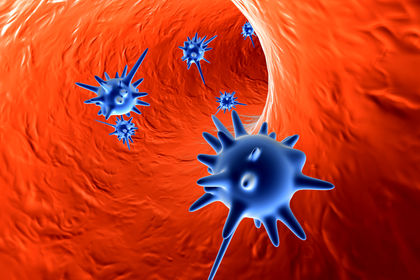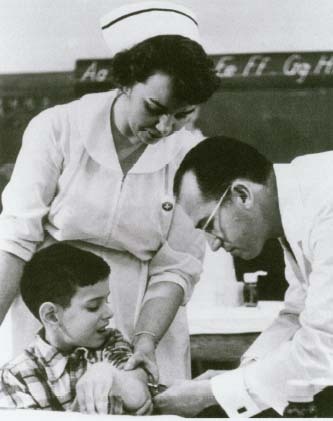Polio

Poliomyelitis (po-lee-o-my-uh-LYE-tis) is a condition caused by the polio virus that involves damage of nerve cells. It may lead to weakness and deterioration of the muscles and sometimes paralysis.
KEYWORDS
for searching the Internet and other reference sources
Albert Sabin
Inactivated poliovirus vaccine (IPV)
Jonas Salk
Oral polio vaccine (OPV)
Paralysis
Postpolio syndrome
Vaccine-associated paralytic polio (VAPP)
What Is Polio?
Poliovirus, part of the enterovirus * group, makes its home in the gastrointestinal * tract, but when the viral infection spreads it can destroy nerve cells known as motor neurons, which make muscles work. The damaged motor neurons cannot rebuild themselves, and as a result the body's muscles no longer function correctly.
Poliovirus infections are broken down into four types: asymptomatic (a-simp-toh-MA-tik), abortive, nonparalytic (non-pair-uh-LIH-tik), and paralytic (pair-uh-LIH-tik). Most cases of polio cause no symptoms (asymptomatic) or only minor symptoms (abortive), such as sore throat, vomiting, or other symptoms resembling those of the flu. Nonparalytic polio has more severe symptoms, including stiff neck due to meningitis and muscle stiffness in the back and legs. Paralytic polio, the rarest but most severe form of the disease, attacks the central nervous system (the part of the nervous sysem that includes the brain and spinal cord) and can cause muscle weakness, spasms, and paralysis.
Types of paralytic polio include spinal, bulbar (BUL-bar), and bulbospinal (bul-boh-SPY-nul). The spinal type is most common, affecting the muscles of the legs, trunk, and neck. The bulbar form involves nerves of the brain stem * and can cause problems with breathing, talking, and swallowing. Bulbospinal polio is a combination of the first two types.
* enterovirus (en-tuh-ro-W-rus) is a group of viruses that can infect the human gastrointestinal tract and spread through the body causing a number of symptoms.
* gastrointestinal (gas-tro-in-TES-tih-nuhl) means having to do with the organs of the digestive system, the system that processes food. It includes the mouth, esophagus, stomach, intestines, colon, and rectum and other organs involved in digestion, including the liver and pancreas.
* brain stem is the part of the brain that carries messages back and forth between the higher areas of the brain and the spinal cord.
How Common Is Polio?
Polio essentially has been wiped out in the United States and many other developed countries since the introduction of a polio vaccine in 1955. Before that, polio occurred in epidemic * form, with more than 21,000 paralytic cases (mostly children) in the United States in 1952 alone. The last cases of naturally occurring polio infection (known as "wild polio") acquired in the United States were reported in 1979. In the following two decades, only 152 cases of polio were reported, most of them vaccine-associated paralytic polio (VAPP), a rare complication that strikes 1 in 2 million to 3 million people who receive the oral (by mouth) polio vaccine (OPV). The last case of VAPP was recorded in 1999, and children now receive a vaccine containing an inactivated form of the virus that cannot cause polio. Although wild polio has not been found in the United States for more than two decades, it is still present in parts of Africa and Asia.
* epidemic (eh-pih-DEH-mik) is an outbreak of disease, especially infectious disease, in which the number of cases suddenly becomes far greater than usual. Usually epidemics are outbreaks of diseases in specific regions, whereas worldwide epidemics are called pandemics.
* feces (FEE-seez) is the excreted waste from the gastrointestinal tract,
Ending Polio: A Timeline
- 1955:
- Jonas Salk's vaccine containing dead, or inactive, poliovirus (IPV) is licensed, and mass numbers of school children are vaccinated, leading to an enormous decrease in the number of polio cases over the next few years and a 60 to 70 percent prevention rate.
- 1963:
- Albert Sabin's oral polio vaccine (OPV), containing a live but weakened virus, becomes the new recommended vaccination in the United States. It offers lifelong protection, can be swallowed, and is easy to administer; in very rare cases, however, it actually causes paralytic polio.
- 1979:
- The last cases of wild polio are reported in the United States.
- 2000:
- IPV becomes the exclusive polio vaccine used in the United States. Experts believe that because polio has virtually disappeared in the United States, the benefits of using OPV are no longer worth the very small risk of contracting the disease from OPV.
Is Polio Contagious?
Poliovirus is extremely contagious and can pass easily from person to person. The virus typically is found in feces * and can be transmitted when people come into contact with infected matter from bowel movements and unknowingly touch the mouth or nose without washing their hands first. The virus can live in feces for weeks, making the spread of infection difficult to control. It also can spread through contact with tiny drops of fluid from a sick person's mouth or nose or by drinking contaminated water. After entering the mouth or nose, the virus multiplies in the throat or gastrointestinal tract and eventually can invade the bloodstream. The infection is most contagious 7 to 10 days before symptoms begin and for the same period after they appear. The virus spreads more readily in areas with poor sanitation.
What Are the Signs and Symptoms?
People with abortive poliomyelitis can experience:
- fever
- headaches
- sore throat
- nausea (NAW-zee-uh) or vomiting
Nonparalytic poliomyelitis symptoms include:
- fever
- headache
- stiffness or pain in the neck, back, or legs
- muscle stiffness or spasms
- nausea and vomiting
- extreme tiredness
Paralytic poliomyelitis is marked by:
- fever
- stiffness or severe pain in the neck, back, or legs
- muscle spasms
- rapidly increasing muscle weakness leading to paralysis
- difficulty in urinating
- constipation
- difficulty in breathing, talking, and swallowing
How Do Doctors Make the Diagnosis?
Polio has been nearly wiped out worldwide. Because polio is no longer found in the United States, a doctor may ask about any recent travel to countries where the disease still occurs. A doctor may suspect polio in an ill patient with paralysis, particularly if the person has not been immunized against polio. During a physical examination, a doctor looks for evidence of muscle paralysis. Samples of blood, bowel movements, fluid from the throat, or cerebrospinal fluid * may be taken and tested for the virus.
* cerebrospinal (seh-ree-bro-SPY-nuhl) fluid is the fluid that surrounds the brain and spinal cord.
What Is the Treatment for Polio?
There is no cure for polio. Easing a patient's symptoms is the best treatment for the disease. Controlling pain and muscle spasms and watching for progression of muscle weakness so supportive care can be given are the main parts of treatment. Abortive cases and many nonparalytic cases of polio usually are helped by rest, fluids, and pain medication. Moist heat on muscles can ease stiffness. Antibiotics may be prescribed to treat bacterial infections that can occur in patients with polio, such as urinary tract infections * .
Patients with severe cases of polio, particularly the paralytic form, often require hospitalization. In the 1940s and 1950s, patients were placed inside metal tanks called "iron lungs" that assisted their breathing. Although medical technology has progressed since then, many people who have polio still need machines called ventilators * to assist breathing as they recover, as well as additional supportive care. Patients with paralytic polio may need physical therapy, crutches, leg braces, or surgery to help them regain their strength and movement.
What to Expect
If the disease does not damage the spinal cord and brain, patients typically make a full recovery. Symptoms in cases of abortive polio generally last less than a week, whereas in nonparalytic cases symptoms can last 1 to 2 weeks. If the polio infection causes paralysis, it can take months for muscles to begin to regain their strength and mobility. Paralysis that lingers after 12 months usually is considered permanent. Complications include:
- permanent paralysis, usually in the legs but sometimes in other muscles as well
- breathing problems due to muscle paralysis or damage to areas of the brain that control breathing
- pneumonia * due to swallowing difficulties
- fluid in the lungs
- urinary tract infections
- kidney stones *
- high blood pressure
- postpolio syndrome, which affects 25 to 50 percent of people previously infected and develops 15 to 40 years after the initial infection, causing symptoms of muscle pain, new or increased weakness, and paralysis
* urinary tract Infections, or UTIs, are infections that occur in any part of the urinary tract. The urinary tract is made up of the urethra, bladder, ureters, and kidneys.
* ventilator (VEN-tuh-lay-ter) is a machine used to support or control a person's breathing.
* pneumonia (nu-MO-nyah) is Inflammation of the lung.
* kidney stones are hard structures that form in the urinary tract. These structures are composed of crystallized chemicals that have separated from the urine. They can obstruct the flow of urine and cause tissue damage and pain as the body attempts to pass the stones through the urinary tract and out of the body.
How Can Polio Be Prevented?
The polio vaccine is the best way to prevent the disease; its use has eliminated polio from the Western Hemisphere. Jonas Salk developed the first vaccine in 1955. It is known as inactivated poliovirus vaccine (IPV), because the poliovirus used to make the vaccine was "killed," or inactivated. Several years later, Albert Sabin developed an oral polio vaccine, which was given in the form of drops that could be swallowed. These drops contained a live, but weakened, virus.

OPV was very successful in helping rid the United States of polio. Its advantage over IPV was that once children had been immunized, they could pass the weakened virus to others who had not received the vaccine in the same way that the infectious poliovirus spread between people. This contact with the virus gave unvaccinated children immunity as if they had been vaccinated. In rare cases, however, because it contained a live virus OPV actually caused paralytic polio in the children who received the vaccine or in people who had close contact with them and had not been immunized. This is known as vaccine-associated paralytic polio. People with weakened immune systems were most at risk for VAPP.
IPV is now the only polio vaccine used in the United States, and it does not cause VAPP. Children might have a sore spot where they receive the shot, but there are rarely any side effects from the vaccine. Children receive IPV routinely as part of the childhood immunization schedule. Most adults who were vaccinated as children do not need to receive the vaccine again. People traveling to places where polio is still found (such as Africa and Asia), lab workers who handle poliovirus, and medical professionals who care for patients with polio may need to be vaccinated again. If polio is wiped out worldwide, immunization against polio may not be needed in the future.
See also
Meningitis
Vaccination (Immunization)
Resources
Organization
U.S. Centers for Disease Control and Prevention (CDC), 1600 Clifton
Road, Atlanta, GA 30333. Through the website of the National
Immunization Program, the CDC provides information about polio and
immunization schedules and vaccines.
Telephone 800-311-3435
http://www.cdc.gov/nip/
Websites
KidsHealth.org
. KidsHealth is a website created by the medical experts of the Nemours
Foundation and is devoted to issues of children's health. It
contains articles on a variety of health topics, including polio.
http://www.KidsHealth.org
The Public Broadcasting System traces the history of polio in the United States through its companion website to the video A Paralyzing Fear: The Story of Polio in America. http://www.pbs.org/storyofpolio/polio/index.html
The World Health Organization's Global Polio Eradication Initiative website offers facts, news, and immunization information about the disease. http://www.polioeradication.org
Comment about this article, ask questions, or add new information about this topic: